Sites: news | india | latam | brasil | indonesia
Feeds: news | india | latam | brasil | indonesia
topic: Marine Birds
Social media activity version | Lean version
South Africa’s penguins heading toward extinction; will no-fishing zones help?
- With just 10,000 breeding pairs left, the endangered African penguin (Spheniscus demersus) could be extinct in the wild by 2035 if the current rate of population decline continues.
- To protect the bird’s food supply and slow its population collapse, South Africa is throwing a protective no-fishing cordon around its main breeding colonies for a period of 10 years.
- But the devil is in the details, and conservationists say the cordons are too small to ensure the penguins get enough fish.
- Negotiations over whether to adjust the cordons are continuing in advance of an early 2024 deadline.
From rat-ridden to reserve, Redonda is an island restoration role model
- In 2016, conservationists began restoring the island of Redonda, part of Antigua and Barbuda in the Caribbean, by removing invasive rats and goats.
- Shortly after removing these invasive species, vegetation on the island sprang back to life, and seabirds and other wildlife recolonized the island.
- In September 2023, the government of Antigua and Barbuda announced it had established the Redonda Ecosystem Reserve, covering nearly 30,000 hectares (74,000 acres) of land and sea.
- Experts say they hope Redonda’s restoration and successive protection will be used as a model for similar projects across the Caribbean.
‘Catastrophic breeding failure’ for penguins as Antarctic sea ice vanishes
- Researchers found that a lack of sea ice around Antarctica’s Bellingshausen Sea led to “unprecedented” breeding failure in four of five emperor penguin colonies.
- Sea ice cover in Antarctica has been experiencing record lows, which could spell disaster for the future of this iconic Antarctic species.
- Previous estimates have suggested that if current rates of global warming persist, more than 90% of emperor penguin colonies would be “quasi-extinct by the end of the century.”
Photos: Sri Lanka’s Kalametiya lagoon draws tourists to see native and migrant birds
- Nature plays a significant role in Sri Lanka’s tourism economy, and it goes well beyond popular parks and wildlife tourism focused on keystone species such as elephants and leopards it’s known for to include birdwatching.
- Birdwatching and photography are drivers of nature-based tourism, and in Sri Lanka’s deep south, the Kalametiya and Lunama lagoons, famous as a bird-watching location, provide visitors the opportunity to see more than 160 bird species, including winter migrants.
- Despite the tourism industry nosediving due to the twin effects of COVID-19 and the collapse of the island’s economy in 2021-22, nature-based tourism continues to draw visitors, indicating Sri Lanka’s popularity not only as a tourist destination but also as a niche wildlife and nature-based tourism location.
- The Wildlife Department’s statistics show that 50% of foreign tourists to Sri Lanka visit at least one national park during their stay, reflecting the level of interest in the island’s biodiversity and nature reserves.
S. Africa to purge bird-eating mice from key albatross breeding island
- Non-native house mice arrived on Marion Island in the southern Indian Ocean two centuries ago, when the island was a stopping-off point for sealing ships.
- Their population has exploded recently, as temperatures warm and summers lengthen. With more mouths to feed, they’ve gutted their main food source — insects — and are now feeding on seabird chicks and adults.
- While mouse attacks on seabirds remain low and their impact on nesting or breeding success isn’t known yet, conservationists nevertheless see them as a serious and growing threat.
- Now the South African government is planning a rodent eradication program for mid-2025 that will be the largest of its kind on a sub-Antarctic island.
Penguins ‘enrich our lives’: Q&A with Pablo Borboroglu, protector of penguins
- Pablo Garcia Borboroglu, a marine biologist from Patagonia, Argentina, was recently awarded the 2023 Indianapolis Prize for his work in protecting penguins around the world.
- Penguins face many threats, including pollution, human disturbance, and the impacts of fisheries and climate change.
- Borboroglu has helped protect penguins through various actions, including establishing marine and terrestrial protected areas, conservation research programs, and educational programs.
Studies show oyster reef restoration can work out well — given enough time
- Researchers have found that the restoration of eastern oyster (Crassostrea virginica) reefs in the U.S. have been largely successful, improving oyster production, enhancing habitat, and increasing nitrogen cycling.
- They also found that oyster restoration was more successful in deeper, saltier parts of coastal waters and that it generally took at least eight years for restored reefs to yield long-term benefits.
- But since the 1800s, more than 85% of global reefs have disappeared due to overfishing, disease and other anthropogenic pressures.
- Researchers say their findings can help restoration managers identify which ecosystem services can benefit from their work, how long those benefits might take to accrue, where to construct oyster reefs.
Seabird conservation mostly works, comprehensive new data set shows
- Researchers compiled a data set of seabird restoration projects, including those that used translocation and social attraction, from around the world.
- Ornithologist Stephen Kress pioneered translocation and social attraction, but these methods have been used more than 850 times in the last 70 years — mostly to great success.
- Experts say seabirds are one of the most threatened bird groups in the world, and translocation and social attraction can help protect them against threats like invasive species and the impacts of climate change.
What’s black and white and spins? Wind turbines that don’t kill birds
- A new study suggests a way to stop seabirds from colliding with wind turbines: painting a black-and-white pattern on all three blades and the pylon to produce a flickering effect.
- This strategy has yet to be tested or implemented, but experts believe it has promise and would create its desired effect.
- However, getting approval for painting wind turbines can be difficult, and this mitigation strategy might generate the unintended effect of displacing seabirds, one expert says.
- It’s estimated that wind turbines kill thousands of birds in the U.K. alone.
‘Plasticosis’: the new disease killing seabirds and likely many other species
- Scientists have identified a new fibrotic disease called “plasticosis” in flesh-footed shearwaters, a species that inadvertently consumes plastic.
- They found that plasticosis was even present in shearwaters with only a small quantity of plastic in their stomachs.
- While this plastic-related disease has thus far only been identified in flesh-footed shearwaters, experts say that nearly every organism — including humans — is being impacted by plastic in some way.
After decades away, rare Peruvian seabird nests on island freed of invaders
- Chañaral Island off the coast of Chile used to be a prime nesting site for the Peruvian diving petrel, but the species largely disappeared from the island after the introduction of invasive rabbits and foxes.
- In 2013, researchers and wildlife managers eradicated these invasive species from Chañaral, and in 2019, a team began to lure the diving petrels back to the island by creating artificial nests and playing petrel calls.
- These efforts paid off: in November 2022, a Peruvian diving petrel chick hatched in a naturally dug burrow, generating optimism for the species’ future on the island.
Avian flu hits Peru, killing thousands of sea birds and infecting some marine mammals
- H5N1, a highly pathogenic avian influenza virus carried generally by wild birds, has arrived in Latin America, causing unprecedented mortality in sea bird colonies along the west coast.
- The virus has killed tens of thousands of sea birds in Peru alone, including some species that are considered endangered in the country, and scientists worry other vulnerable species like the Andean condor might also become infected.
- Hundreds of sea lions and a dolphin have also been infected, which raises concerns regarding transmission to humans and is especially worrisome if it is confirmed that mammals can infect each other.
- The outbreaks also threaten Peru’s guano industry, which provides affordable fertilizer to many small-scale farmers in the region, and could expose people harvesting guano to H5N1.
For threatened seabirds of NE Atlantic, climate change piles on the pressure
- A new report shows that puffins and other seabird species in the Northeast Atlantic are at risk from climate change.
- It warns most seabird species would lose a substantial amount of their current breeding sites and available prey due to climate change, but each species has unique challenges.
- The authors describe potential interventions that conservation experts can enact to protect the species, including the relocation of seabird breeding sites, supplementary feeding, and providing resources that help seabirds deal with extreme weather events such as flooding and heat waves.
Will shipping noise nudge Africa’s only penguin toward extinction?
- The African penguin (Spheniscus demersus) is expected to go extinct in the wild in just over a decade, largely due to a lack of sardines, their main food.
- A colony in South Africa’s busy Algoa Bay is suffering a population crash that researchers say coincides with the introduction of ship-to-ship refueling services that have made the bay one of the noisiest in the world.
- They say theirs is the first study showing a correlation between underwater noise pollution and a seabird collapse.
- Current studies are investigating whether the ship noise is interfering with the penguins’ foraging behavior and their ability to find fish.
Breeding success raises hopes for future of endangered African penguin
- Two African penguin chicks have hatched at a nature reserve in South Africa where conservationists have been working for years to entice the endangered birds to breed.
- The colony was abandoned more than 10 years ago after a caracal killed a number of penguins.
- The recent hatching comes at a time when survival prospects for Africa’s only resident penguin species look grim, due mainly to declining food stocks.
- But encouraging new colonies at sites close to abundant food sources could help to bring the species back from the brink.
Plastic impacts a grossly underestimated ‘one-two punch’ for seabirds: Study
- That plastic pollution is harmful to marine life, including seabirds, is well known, but recent research finds that the impacts may be “grossly underestimated” and that plastics can affect multiple organs.
- A new study investigated plastic ingestion by flesh-footed shearwaters and found that — as was determined in past research — initial consumption can harm the stomach. New evidence also showed that impacts are far more expansive, and may cause ongoing health problems distributed throughout body organs.
- Some forms of tissue damage detected by the new research suggest that plastic particles may also act as chemical pollutants, though this requires further study.
- Plastic pollution is a massive growing problem for the world’s oceans and marine life. Earlier this year, researchers announced that the global planetary boundary for novel entities — including plastics — has been surpassed, threatening Earth’s operating systems and life as we know it.
In a hotter, drier climate, how serious is fire risk to island seabirds?
- A new study suggests that fires on remote islands in southwest Australia pose a rising threat to short-tailed shearwaters and other seabirds as climate change creates hotter and drier conditions.
- In 2021, a research team led by Jennifer Lavers surveyed an island in Western Australia’s Recherche Archipelago a year after a fire event, and found little evidence that short-tailed shearwaters had successfully bred after the fire, ignited by a lightning strike, had swept over most of the island.
- Lavers and her research team suggest that Indigenous-led methods of controlled burning could help reduce the risk of catastrophic fires that would endanger seabirds.
- However, a seabird and island expert not connected with the study disagrees that fire currently poses a major threat, since seabirds have been known to rebound from fires, even after the loss of their fledglings and burrows.
‘Birds are messengers’: Q&A with BirdLife’s Patricia Zurita
- Next month BirdLife International, a global partnership of 115 organizations working to protect birds and their habitats, will mark its 100th anniversary by holding the BirdLife World Congress in London.
- BirdLife has a lot to celebrate on its 100th birthday. It counts more than 2.5 million members across its partner organizations, which include the Royal Society for the Protection of Birds, the National Audubon Society, and the American Bird Conservancy, among others. It has also identified and documented more than 13,000 Important Bird and Biodiversity Areas (IBAs) – “places of global significance for the conservation of birds and other biodiversity” – and helped protect 2,000 high priority conservation sites around the globe.
- But with bird populations and habitats declining worldwide, BirdLife still has much to do.
- BirdLife’s CEO Patricia Zurita spoke with Mongabay’s Founder Rhett A. Butler about the Birdlife’s work, how conservation is evolving, and her own experiences as an Ecuadorian economist who took the helm of BirdLife in 2015 as the first woman from a middle income tropical country to lead a major international conservation organization.
Rachel Carson’s ‘Silent Spring’ 60 years on: Birds still fading from the skies
- Rachel Carson’s “Silent Spring” catalyzed the modern environmental movement and sparked a ban on DDT in the U.S. and most other nations, though DDT has since been replaced by a growing number of other harmful biocides.
- Now, 60 years later, birds may face more threats than any other animal group because they live in — or migrate through — every habitat on Earth. Birds are impacted by land-use changes, pollution (ranging from pesticides to plastics), climate change, invasive species, diseases, hunting, the wildlife trade, and more.
- The 2022 update to the “State of the World’s Birds” report notes winners and losers amid increasing human alteration of the planet, but documents a continuing downward trend.
‘Bring back burning culture’ to save seabirds: Q&A with Wudjari ranger Jennell Reynolds
- Jennell Reynolds, a Wudjari woman of the Nyungar nation and senior member of the Tjaltjraak Ranger program based in Esperance, Western Australia, says cultural burning can help protect seabird breeding sites on the islands of the Recherche Archipelago.
- The region has been experiencing particularly hot and arid weather, heightening the fire risk on the 105 islands that make up the Archipelago.
- Shearwaters return to the same place each year to breed, but it’s difficult for the species to create burrows when fire has burnt away the vegetation that holds the ground together.
- While cultural burning has yet to be reinstated on the islands, Reynolds says it can stabilize key areas of vegetation and seabird breeding and nesting grounds.
Oil spill contaminates wildlife, beaches and protected areas in Peru
- On Jan. 15, a refinery owned by Spanish oil company Repsol spilled nearly 12,000 barrels of oil into the sea off Lima, Peru, as it was pumping the oil from a tanker.
- Experts have questioned why the refinery of La Pampilla was operating that day, when there were unusually high waves caused by the Tonga volcano eruption and tsunami.
- Peru’s Environmental Evaluation and Enforcement Agency (OEFA) has fined Repsol for similar spills on at least three prior occasions, and this time the company could be hit with more than $37 million in fines.
- The spill has spread beyond the Lima coast and out toward islands that are part of a network of protected nature reserves, posing serious threats to marine life and to artisanal fishermen.
As climate change melts Antarctic ice, gentoo penguins venture further south
- Researchers have discovered a new colony of gentoo penguins in Antarctica previously unknown to science.
- The colony was found on Andersson Island on the east side of the Antarctic Peninsula, which is the furthest south the species has ever been found in that region.
- Scientists say climate change played a key role in the penguins’ presence on the island, as warming temperatures and record ice melt make new locations habitable for the species.
- Scientists and conservationists are making renewed calls to establish a network for marine protected areas in Antarctica to help safeguard the region as the climate rapidly changes.
Arctic biodiversity at risk as world overshoots climate planetary boundary
- The Arctic Ocean biome is changing rapidly, warming at twice the rate of the rest of the world. In turn, multiyear sea ice is thinning and shrinking, upsetting the system’s natural equilibrium.
- Thinner sea ice has led to massive under-ice phytoplankton blooms, drawing southern species poleward; fish species from lower latitudes are moving into the peripheral seas of the Arctic Ocean, displacing and outcompeting native Arctic species.
- Predators at the top of the food chain, such as polar bears, are suffering the consequences of disappearing ice, forced onto land for longer periods of time where they cannot productively hunt.
- The Central Arctic Ocean Fisheries Agreement has been signed by 10 parties to prevent unregulated commercial fishing in the basin until the region and climate change impacts are better understood by scientists. International cooperation will be critical to protect what biodiversity remains.
Layers of regulations to protect European seas ‘not working,’ audit finds
- A recent report published by the European Court of Auditors (ECA) found that the European Union (EU) was not doing enough to protect and restore its oceans, despite having various policies in place to support conservation efforts.
- In particular, the ECA report found that only 1% of more than 3,000 marine protected areas (MPAs) in EU waters provided full protection to marine habitats, and that the MPAs generally failed to protect biodiversity.
- The report also found that sustainable fishing and environmental standard targets were not being met, some policies were out of date, and that EU funding was not being adequately utilized for conservation efforts.
- A recent report by the NGO Oceana on trawling activities in sensitive marine habitats in the Mediterranean provides further evidence that EU policies are not doing enough to protect its seas.
The promise of ‘bird-friendly’ cities: Q&A with author Timothy Beatley
- University of Virginia professor Timothy Beatley lays out a case for building cities that are better hosts to birds and the broader natural world in The Bird Friendly City: Creating Safe Urban Habitats.
- His case rests on the benefits that birds provide, and he discusses the need for equal access to nature for all city-dwelling communities.
- From small home improvements to skyscrapers covered in greenery, Beatley covers the adaptations necessary for more “natureful” cities around the world.
A Chilean archipelago rivaling the Galápagos fends off invasive species
- Juan Fernández Archipelago National Park in Chile is home to a wealth of species found nowhere else on Earth, where the proportion of endemic plants surpasses even the more celebrated Galápagos Islands.
- Among the native bird species here is the pink-footed shearwater, which breeds only on the Juan Fernández islands and another Chilean island, but is threatened by the livestock and feral dogs, cats, rabbits and coatis introduced by humans.
- To prevent these animals from destroying or stealing the shearwaters’ nesting burrows and eating the birds or their young, a fence is being built around a critical nesting site.
- These concerted efforts to save the pink-footed shearwater, including a successful rabbit cull on one of the islands, make the species the first marine bird to be protected within a national conservation plan.
Civil war didn’t hurt this Sri Lankan mangrove forest, but shrimp farming might
- Environmentalists have opposed plans to establish shrimp farms in the Vidattaltivu nature reserve, home to an important mangrove forest and biodiversity-rich marine habitat in northern Sri Lanka.
- Critics say the plan goes against the government’s wider efforts to conserve mangrove areas.
- They also point to the failure of a similar project to establish firm farms in a mangrove area, which resulted in 90% of the farms being abandoned because of disease outbreaks among the shrimp.
- The plan also threatens the hundreds of thousands of migratory birds that stop to feed in the area during their long journeys along the Central Asian Flyway.
Decade after BP Deepwater Horizon spill, oil drilling is as dangerous as ever
- Ten years ago, the BP Deepwater Horizon exploratory rig exploded, killing 11 people and initiating the largest oil spill in the history of the United States.
- Nearly 5 million barrels of oil spilled into the Gulf of Mexico, causing catastrophic damage to the ecosystem and economy of the region.
- A newly published report by the nonprofit Oceana looks back at how this spill happened, the resulting ecological and economic impacts, and if this catastrophe has changed government or oil industry approaches to offshore drilling.
- Poor government oversight and inadequate safety culture paved the way for the BP Deepwater Horizon explosion. Now, a decade later, it appears these conditions, the prerequisites for disaster, have not improved.
Bid to get ‘aquatic wild meat’ off the menu and under protection
- The term “aquatic wild meat,” or “marine bushmeat,” refers to the hunting of marine mammals, reptiles, seabirds and now some sharks and rays.
- The hunting takes place all over the world and has increased in recent years as small-scale fishers have lost access to fish and other marine resources.
- Last week, delegates representing more than 80 countries took steps to address the issue of aquatic wild meat at the Convention on the Conservation of Migratory Species of Wild Animals conference in Gandhinagar, India.
- Other outcomes of the conference included adding 10 new species to the convention’s protected lists, including the jaguar and Asian elephant, recognizing the culture of wild animals, and calling for migratory species to be considered in national climate and energy policies.
Tool use in puffins may point to ‘underestimated’ intelligence in seabirds
- A camera trap in Iceland captured video of an Atlantic puffin using a stick to scratch itself.
- The discovery, along with a similar observation in Wales in 2014, is the first evidence of tool use in seabirds.
- The findings suggest that seabirds like puffins may be more intelligent or possess greater problem-solving skills than once thought.
Vanishing sea ice in the Arctic could shake up seabird migrations
- Researchers have developed a framework to aid in understanding the changes to seabird migration that could result from the loss of Arctic sea ice due to climate change.
- The team found that one species, the little auk, would expend about half as much energy by shifting its migration from the North Atlantic to the North Pacific, rather than their traditional migration or if they just stayed put in the high Arctic.
- The team also mined the scientific literature and found 29 bird species with the potential for a similar shift in their migratory routes.
Emperor penguins could disappear by 2100 if nations don’t cap emissions
- Researchers have combined a global climate model that projects where and when sea ice forms and a model of penguin populations to predict how penguin colonies would react to changing sea ice under future climate scenarios.
- The models found that under the business-as-usual scenario, where countries fail to halt climate change, emperor penguin numbers will decline by around 86 percent by 2100.
- However, if countries meet the objectives of the Paris Agreement, limiting the global increase in temperature to 1.5 degrees Celsius (2.7 degrees Fahrenheit) above pre-industrial levels, then emperor penguin numbers would decline by about 31 percent, giving them a fighting chance at survival.
Sponges supply DNA for new method of monitoring aquatic biodiversity
- Tracking environmental DNA (eDNA) is fast becoming a popular method of monitoring aquatic biodiversity, but current methods are expensive and cumbersome.
- Filter-feeding sponges can act as natural sieves to collect and concentrate eDNA from seawater.
- Using sponge samples collected from the Antarctic and the Mediterranean Sea, researchers identified 31 organisms, including fish, penguins, and seals, clearly separated by location.
- Although the method is still a proof of concept, it may lead to the development of simpler, less expensive technologies for aquatic eDNA collection.
The health of penguin chicks points scientists to changes in the ocean
- A recent closure of commercial fishing around South Africa’s Robben Island gave scientists the chance to understand how fluctuations in prey fish populations affect endangered African penguins (Spheniscus demersus) absent pressure from humans.
- The researchers found that the more fish were available, the better the condition of the penguin chicks that rely on their parents for food.
- This link between prey abundance in the sea and the condition of penguin chicks on land could serve as an indicator of changes in the ecosystem.
’Unprecedented’ loss of biodiversity threatens humanity, report finds
- The U.N.’s Intergovernmental Science-Policy Platform on Biodiversity and Ecosystem Services released a summary of far-reaching research on the threats to biodiversity on May 6.
- The findings are dire, indicating that around 1 million species of plants and animals face extinction.
- The full 1,500-page report, to be released later this year, raises concerns about the impacts of collapsing biodiversity on human well-being.
Large emperor penguin colony suffers ‘catastrophic’ breeding failure
- Until recently, the emperor penguin colony at Halley Bay on the Weddell Sea in the Antarctic was one of the world’s largest, supporting between 14,000 to 25,000 breeding pairs, or around 5 to 9 percent of the bird’s global population.
- Since 2016, satellite images have shown that the colony has suffered a complete breeding failure, something that’s never been recorded before.
- This breeding failure started in 2016 when, following abnormal stormy weather, the sea ice broke up in October, long before the chicks had fledged and were ready to go out to sea. In 2017 and 2018, the sea ice broke up early too, leading to the likely death of all chicks.
- Around the same time, there was a massive increase in the numbers of emperor penguins at the Dawson-Lambton Glacier penguin colony 55 kilometers (34 miles) south of Halley Bay, suggesting that many of the emperor penguins from Halley Bay had moved to Dawson-Lambton.
Bird flu in Namibia’s penguins wanes, after killing nearly 500
- More than 450 African penguins, an IUCN-listed endangered animal, have died in an outbreak of bird flu on three islands off the coast of Namibia.
- The virus, H5N8, is thought to have been introduced to the colonies, which hold 96 percent of Namibia’s penguins, by another bird traveling from South Africa, where a similar outbreak occurred in 2018.
- The disease appears to be abating, and researchers are hopeful that the country’s penguins will recover.
- However, they continue to face threats from food shortages caused by overfishing and climate change.
Swelling amount of plastic in the ocean confirmed by new study
- A new study used log books from 60 years of plankton research to document the increase in the amount of plastic in the ocean.
- The study’s authors tabulated the entanglements of the continuous plankton recorder, a sampling device that’s towed behind ships, revealing a significant increase in plastic in the ocean since the 1990s.
- Scientists have long suspected such a trend but have been unable to demonstrate it with data until now.
Scientists urge overhaul of the world’s parks to protect biodiversity
- A team of scientists argues that we should evaluate the effectiveness of protected areas based on the outcomes for biodiversity, not simple the area of land or ocean they protect.
- In a paper published April 11 in the journal Science, they outline the weaknesses of Aichi Biodiversity Target 11, which set goals of protecting 17 percent of the earth’s surface and 10 percent of its oceans by 2020.
- They propose monitoring the outcomes of protected areas that measure changes in biodiversity in comparison to agreed-upon “reference” levels and then using those figures to determine how well they are performing.
To stop extinctions, start with these 169 islands, new study finds
- New research shows that culling invasive, non-native animals on just 169 islands around the world over roughly the next decade could help save almost 10 percent of island-dwelling animals at risk of extinction.
- A team of scientists surveyed nearly 1,300 islands where 1,184 threatened native animals have collided with 184 invasive mammals.
- Their analyses gave them a list of 107 islands where conservationists could start eradication projects by 2020, potentially keeping 80 threatened species from sliding closer to extinction.
Wisdom, world’s oldest known wild bird, is a mother again at 68
- Wisdom, a Laysan albatross, is believed to be at least 68 years old and is the world’s oldest known wild bird.
- She returned to her regular nesting site in Midway Atoll National Wildlife Refuge, located within the Papahānaumokuākea Marine National Monument in the northern Pacific, in November last year, and her new chick hatched earlier this month.
- Millions of Layson albatrosses were slaughtered in the early 1900s for their feathers, which were used in hats in Europe. That makes Wisdom’s contribution to the species’ regeneration important as it recovers from the large-scale hunting, biologists say.
Warmer waters shrink krill habitat around Antarctica
- A new study has found that fewer young krill are surviving to adulthood around Antarctica as ocean temperatures have risen in the Southern Ocean in the past few decades.
- The researchers, who looked at decades of data on krill body lengths and abundance, found that the highest densities of krill had shifted southward by some 440 kilometers (273 miles) since the 1920s.
- The scientists note that the findings could alter food webs in the Southern Ocean.
- Currently, the internationally managed krill fishery does not take the location and size of the krill population into account.
Bans on the bird trade in South America yield mixed results
- After decades of rampant exports, several South American countries banned the international trade of wild-caught birds.
- In some cases, in concert with conservation, the bans have helped bird populations recover, leading several countries to invest in birdwatching tourism.
- However, the bans have also led to a significant illegal trade on the continent and a shift of the economic benefits from the wild bird trade to other countries.
Feed a fishery, starve a seabird
- Industrial fisheries increased their share of fish taken by 10 percent, while seabirds’ take dropped by nearly 20 percent, between 1970-1989 and 1990-2010, new research has found.
- The study mapped out 40 years of data comparing the takes of seabirds and fisheries during that timeframe.
- Scientists say that seabirds, which also face threats from pollution, plastic garbage and possible entanglements, could also face starvation as a result of the competition with large-scale fisheries for the same resource.
‘Drifters of opportunity’: Seabirds track energy in tidal currents
- A recent study used location data from GPS-tagged seabirds called razorbills to track currents in the Irish Sea.
- When a team of biologists compared the movements of resting birds on the surface of the water with a mathematical model that lays out the currents, they found that the birds provided solid information on the speed and direction of the flow of water.
- The researchers suggest that similar research using data from resting seabirds could help identify areas for the harvest of renewable tidal energy.
Photos: Here are the winners of the 2018 British Ecological Society photo contest
- Chris Oosthuizen of South Africa’s University of Pretoria won the top prize in the British Ecological Society’s “Capturing Ecology” photo competition this year with an image of a single colorful adult king penguin amidst a crowd of brown-colored chicks on Marion Island, part of the Prince Edward Islands in the Indian Ocean.
- Oosthuizen is hopeful that the prize-winning photo might help draw attention to the challenges king penguins face due to the impacts of human activities. “Although the global population of king penguins is large, populations inhabiting islands around the Antarctic face an uncertain future,” he said.
- In total, some 16 images were recognized this year by the British Ecological Society. “Capturing flora and fauna from across the planet, subjects range from African wild dog research to an artistic take on Galapagos iguanas to images exploring the relationships between people and nature,” the group said in a statement.
Largest king penguin colony in the world has shrunk by 90%
- In 1982, researchers estimated that there were more than 500,000 breeding pairs and over 2 million king penguins on the remote Île aux Cochons, or Pig Island, a French territory in southern Indian Ocean.
- More than three decades later, by 2017, the number of king penguins on the island had dropped drastically to just about 200,000 penguins, including some 60,000 breeding pairs, researchers report in a new study.
- The reasons for this decline are still unknown, but the researchers hope that further field studies will be able to verify the massive drop and identify the factors that led to it.
A boon for birds: Once overlooked, China’s mudflats gain protections
- The shoreline of the Yellow Sea has been transformed dramatically over the last half-century as mudflats have been filled in with rock and soil, replacing dynamic, natural tidal zones with solid ground for ports, chemical plants and farmland.
- Losing the intertidal flats has proved devastating for the millions of shorebirds that funnel through the Yellow Sea during migration.
- In January, the Chinese government announced a sweeping package of reforms aimed at ending much of the land reclamation taking place on the mudflats.
- “Stunned joy” is how one bird conservationist described her reaction to news of the reforms, which she said could avert one of the biggest extinction crises facing migratory birds — if they work.
African Parks backs marine reserve brimming with wildlife in Mozambique
- The conservation NGO African Parks signed an agreement to manage Bazaruto Archipelago National Park in Mozambique.
- Leaders established the park in 1971, but recent illegal fishing and unregulated tourism has threatened the ecosystem and its economic value, African Parks said.
- The park is home to 2,000 species of fish and hundreds of species of birds, reptiles and mammals, including some of the last dugongs in the western Indian Ocean.
Hard but worth it: researchers fight invasives on Subantarctic islands (commentary)
- Sealers and subsequent human visitors to the Southern Ocean’s windswept islands brought with them a variety of invasive species, such as mice, rats, cats, sheep, and goats, that have wrought havoc on the islands’ native wildlife and ecosystems.
- On Marion Island, midway between South Africa and Antarctica, researchers and conservationists completed the largest successful cat eradication on an island in history in 1993.
- Marion Island’s wildlife has largely rebounded from the sealers and cats, but invasive mice continue to take a toll.
- The author points to other recent successful eradications of invasive species on Subantarctic islands and argues that they are a wise investment with benefits for wildlife as well as research into the region’s ecology and the effects of climate change. The views expressed are the author’s own, not necessarily Mongabay’s.
Namibia’s low cost, sustainable solution to seabird bycatch
- Accidental take of marine animals by commercial fisheries is a serious global environmental problem, with 40 percent of the world’s ocean fishing totals disposed of as bycatch annually.
- Roughly 63 billion pounds of unwanted wildlife — seabirds, marine mammals and sea turtles, countless fish species, rays, and cephalopods — are killed as bycatch due to the swallowing of baited hooks or entanglement in nets.
- Namibia, once known as the “world’s worst fishery” regarding avian bycatch is addressing the problem. It has installed “bird-scaring” lines on the nation’s 70 trawlers and on its 12 longline fishing vessels, and has also adopted other low cost methods to minimize avian bycatch, which once killed more than 30,000 birds annually.
- The Meme Itumbapo Women’s Group, known for its seashell necklaces and other jewelry, is now sustainably manufacturing and supplying the bird-scaring lines from their headquarters “Bird’s Paradise,” in Walvis Bay, Namibia. The hope is that these combined efforts will reduce avian bycatch by 85-90 percent in the near future.
Ecological trap ensnares endangered African penguins
- Juveniles of the Western Cape population of African penguins, an IUCN-listed endangered species, still frequent a subpar hunting ground, even though other options are within reach.
- This population of penguins has declined by 80 percent in recent decades.
- The current research projects that Western Cape penguin numbers are half of what they would be without this ecological trap.
World’s largest marine protected area created in Antarctica
- Last week, 25 governments unanimously agreed to create the world’s largest marine protected area off Antarctica.
- The new marine protected area, expected to come into force in December 2017, will set out to protect some 1.55 million square kilometers of the Ross Sea around Antarctica.
- According to the agreement, 72 percent of the marine area will be set aside as a “no-take” zone, in which all forms of fishing will be banned. The protections will end in 35 years.
Rat eradication needed to save seabird colony
 Although only a nuisance in your home, on an isolated island chain (archipelago) off the northeastern coast of Brazil, rats pose a threat to the red-billed tropicbird (Phaethon aethereus). The seabird nests in the remote Abrolhos National Park, but two species of invasive rats prey on its eggs and young: the house rat (Rattus […]
Although only a nuisance in your home, on an isolated island chain (archipelago) off the northeastern coast of Brazil, rats pose a threat to the red-billed tropicbird (Phaethon aethereus). The seabird nests in the remote Abrolhos National Park, but two species of invasive rats prey on its eggs and young: the house rat (Rattus […]
Saving Peru’s sea turtles and marine birds: conservationists and fishermen partner to tackle bycatch
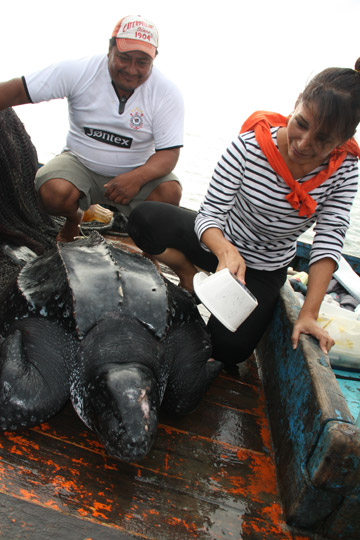 Joanna Alfaro Shigueto will be speaking at the Wildlife Conservation Network Expo in San Francisco on October 11th, 2014. Marine conservationists often view fisheries as an enemy of sorts, vacuuming up fish with little thought to the long-term consequences and using equipment that also ends up killing other species, i.e. bycatch like sea turtles and […]
Joanna Alfaro Shigueto will be speaking at the Wildlife Conservation Network Expo in San Francisco on October 11th, 2014. Marine conservationists often view fisheries as an enemy of sorts, vacuuming up fish with little thought to the long-term consequences and using equipment that also ends up killing other species, i.e. bycatch like sea turtles and […]
Famed bird reappears after 400,000 miles of flight
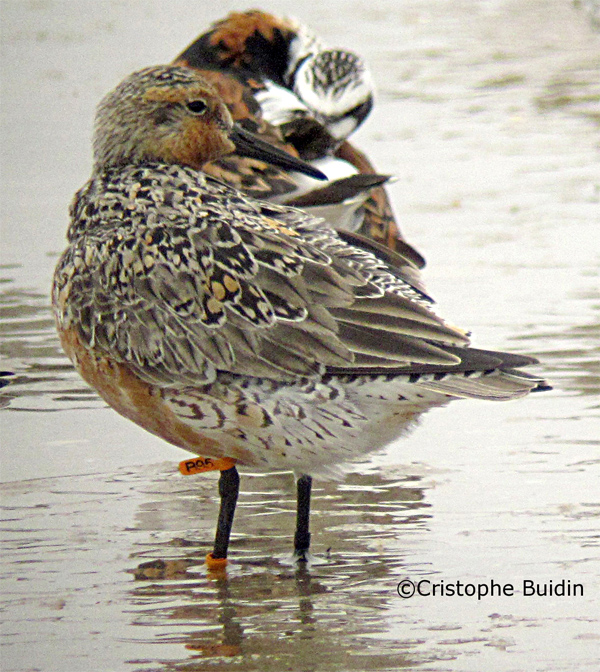 A migratory shorebird that has flown more than 400,000 miles has reappeared once again. The bird, dubbed “B95” after the number on his leg band or “Moonbird” for the distance he has flown over his lifespan, is a rufus red knot (Calidris canutus rufus) that scientists have been tracking for 19 years. Each May his […]
A migratory shorebird that has flown more than 400,000 miles has reappeared once again. The bird, dubbed “B95” after the number on his leg band or “Moonbird” for the distance he has flown over his lifespan, is a rufus red knot (Calidris canutus rufus) that scientists have been tracking for 19 years. Each May his […]
Industrialized fishing has forced seabirds to change what they eat
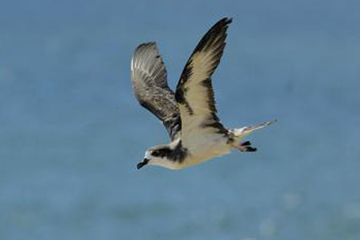 The bleached bones of seabirds are telling us a new story about the far-reaching impacts of industrial fisheries on today’s oceans. Looking at the isotopes of 250 bones from Hawaiian petrels (Pterodroma sandwichensis), scientists have been able to reconstruct the birds’ diets over the last 3,000 years. They found an unmistakable shift from big prey […]
The bleached bones of seabirds are telling us a new story about the far-reaching impacts of industrial fisheries on today’s oceans. Looking at the isotopes of 250 bones from Hawaiian petrels (Pterodroma sandwichensis), scientists have been able to reconstruct the birds’ diets over the last 3,000 years. They found an unmistakable shift from big prey […]
Scientists discover that marine animals disperse seagrass
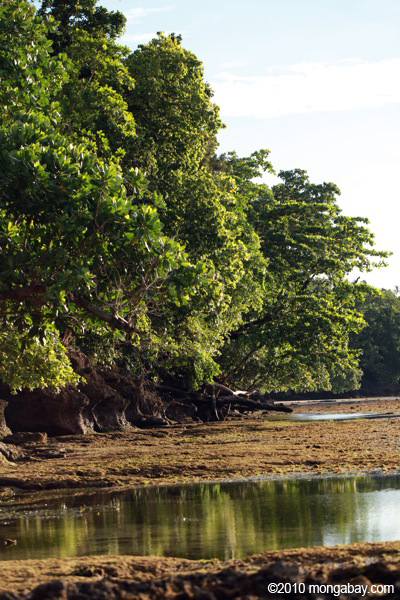 Lesser known than coral reefs, marine seagrass ecosystems are rich in biodiversity and are powerhouses when it comes to sequestering carbon dioxide. Yet, much remains unknown about the ecology of seagrass beds, including detailed information on how seagrass spread their seeds and colonize new area. Now a recent study in Marine Ecology Progress Series documents […]
Lesser known than coral reefs, marine seagrass ecosystems are rich in biodiversity and are powerhouses when it comes to sequestering carbon dioxide. Yet, much remains unknown about the ecology of seagrass beds, including detailed information on how seagrass spread their seeds and colonize new area. Now a recent study in Marine Ecology Progress Series documents […]
Are seagulls killing whales in Patagonia?
 It sounds ludicrous, but it could just be true: scientists say seagulls may be responsible for hundreds of southern right whale mortalities off the Argentine coastline. Since 2003, scientists have documented the deaths of 605 southern right whales (Eubalaena australis) near Península Valdés which the whales use as a nursery. Notably, 88 percent of these […]
It sounds ludicrous, but it could just be true: scientists say seagulls may be responsible for hundreds of southern right whale mortalities off the Argentine coastline. Since 2003, scientists have documented the deaths of 605 southern right whales (Eubalaena australis) near Península Valdés which the whales use as a nursery. Notably, 88 percent of these […]
Above the ocean: saving the world’s most threatened birds
 This post is an expanded version of an article that appeared in August on Yale e360: Easing The Collateral Damage Fisheries Inflict on Seabirds.
This post is an expanded version of an article that appeared in August on Yale e360: Easing The Collateral Damage Fisheries Inflict on Seabirds.
Penguins face a slippery future
 Adelie penguins hunting for food. Photo by: J. Weller. Click to enlarge. Pablo Garcia Borboroglu will be speaking at the Wildlife Conservation Network Expo in San Francisco on October 13th, 2012. Penguins have spent years fooling us. With their image seemingly every where we turn—entertaining us in animated films, awing us in documentaries, and winking […]
Adelie penguins hunting for food. Photo by: J. Weller. Click to enlarge. Pablo Garcia Borboroglu will be speaking at the Wildlife Conservation Network Expo in San Francisco on October 13th, 2012. Penguins have spent years fooling us. With their image seemingly every where we turn—entertaining us in animated films, awing us in documentaries, and winking […]
Cute animal pictures of the day: Humboldt penguin chick meets water
-ZSL.1.568.jpg) Keeper, Vicky Fryson, helps a Humboldt penguin chick, Pickle, test the water for the first time. Photo by: Zoological Society of London’s (ZSL) London Zoo. Humboldt penguins was found along the western edge of South America in Chile and Argentina. They face a barrage of threats including overfishing, drowning as bycatch, El Nino conditions that […]
Keeper, Vicky Fryson, helps a Humboldt penguin chick, Pickle, test the water for the first time. Photo by: Zoological Society of London’s (ZSL) London Zoo. Humboldt penguins was found along the western edge of South America in Chile and Argentina. They face a barrage of threats including overfishing, drowning as bycatch, El Nino conditions that […]
Over 500 dead penguins wash up in Brazil, cause under investigation
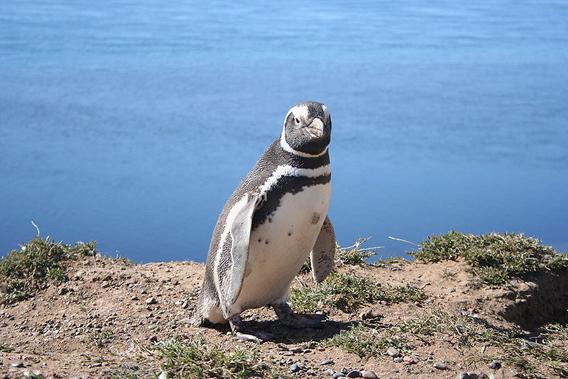 Magellanic penguin in Patagonia. Photo by: Michaël Catanzariti. In recent weeks, 512 Magellanic penguins (Spheniscus magellanicus) have washed up dead in Brazilian state of Rio Grande do Sul. Although badly composed, researchers do not see any obvious signs why the penguins died, especially in such numbers. Marine biologists are currently performing autopsies on carcasses and […]
Magellanic penguin in Patagonia. Photo by: Michaël Catanzariti. In recent weeks, 512 Magellanic penguins (Spheniscus magellanicus) have washed up dead in Brazilian state of Rio Grande do Sul. Although badly composed, researchers do not see any obvious signs why the penguins died, especially in such numbers. Marine biologists are currently performing autopsies on carcasses and […]
B95, the great survivor
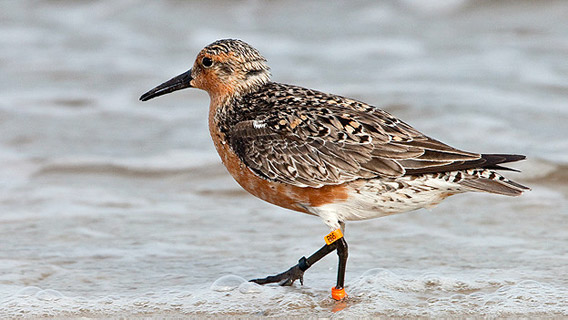 B95, the remarkable rufus red knot who has flown from the Earth to the moon in terms of distance. Photo by: Jan Van de Kam. He is so long-lived that he has surpassed all expectations, touching hearts throughout the American continent, bringing together scientists and schools, inspiring a play and now even his own biography. […]
B95, the remarkable rufus red knot who has flown from the Earth to the moon in terms of distance. Photo by: Jan Van de Kam. He is so long-lived that he has surpassed all expectations, touching hearts throughout the American continent, bringing together scientists and schools, inspiring a play and now even his own biography. […]
Why bird droppings matter to manta rays: discovering unknown ecological connections
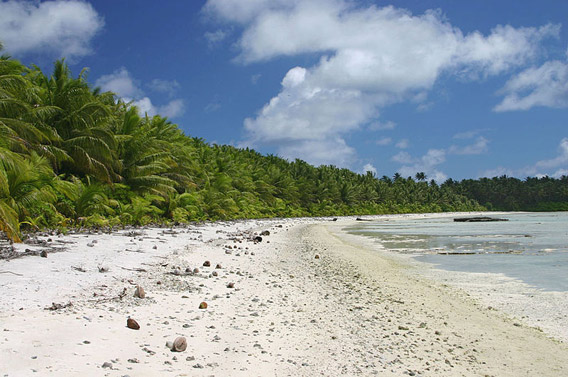 Beach on Palmyra Atoll. Ecologists have long argued that everything in the nature is connected, but teasing out these intricate connections is not so easy. In fact, it took research on a remote, unoccupied island for scientists to discover that manta ray abundance was linked to seabirds and thereby native trees. Working in the U.S. […]
Beach on Palmyra Atoll. Ecologists have long argued that everything in the nature is connected, but teasing out these intricate connections is not so easy. In fact, it took research on a remote, unoccupied island for scientists to discover that manta ray abundance was linked to seabirds and thereby native trees. Working in the U.S. […]
Paleontologists reconstruct extinct, “elegant” penguin
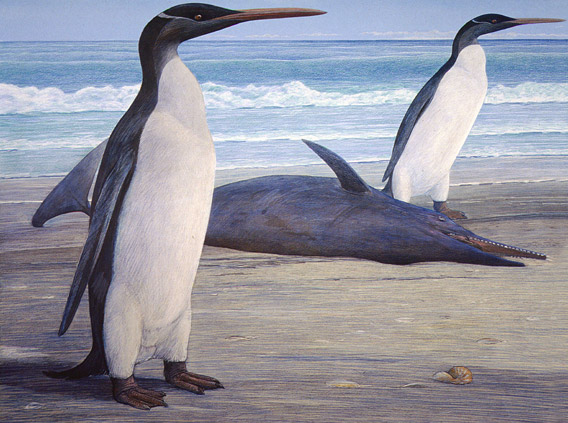 Two Kairuku penguins come ashore, passing a stranded Waipatia dolphin. Artwork by Chris Gaskin, owner and copyright owner: Geology Museum, University of Otago.. Around 25 million years ago a penguin with a long, sharp beak and massive flippers lived in a New Zealand that was almost entirely underwater. The bird, named Kairuku after a Maori […]
Two Kairuku penguins come ashore, passing a stranded Waipatia dolphin. Artwork by Chris Gaskin, owner and copyright owner: Geology Museum, University of Otago.. Around 25 million years ago a penguin with a long, sharp beak and massive flippers lived in a New Zealand that was almost entirely underwater. The bird, named Kairuku after a Maori […]
Small marine fish need protection too
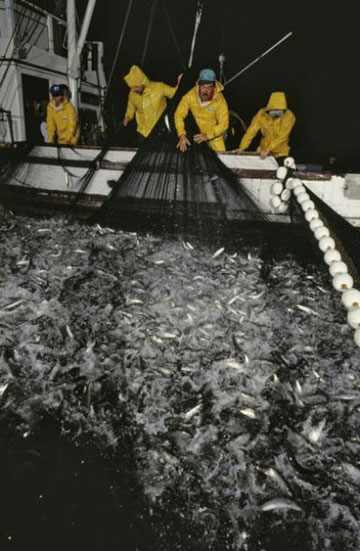 It has long been known that overfishing has decimated some populations of tuna, shark, cod, as well as other big predatory fish; however two recent studies have pointed out that overfishing is also threatening small fish such as anchovies, sardines, mackerel, herring, menhaden, and krill. Although tiny, these species are vital to marine ecosystems since […]
It has long been known that overfishing has decimated some populations of tuna, shark, cod, as well as other big predatory fish; however two recent studies have pointed out that overfishing is also threatening small fish such as anchovies, sardines, mackerel, herring, menhaden, and krill. Although tiny, these species are vital to marine ecosystems since […]
Photos: New Zealand oil disaster kills over 1200 birds to date
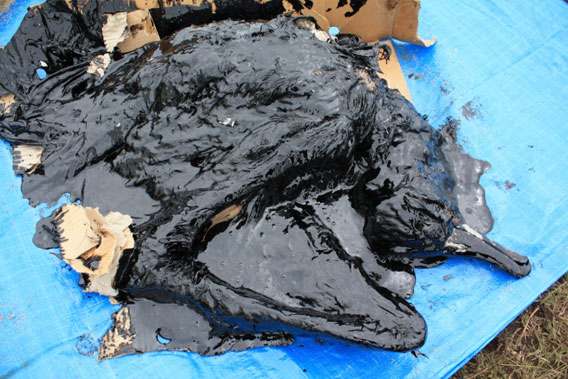 White capped albatross killed by oil. This species is listed as Near Threatened by the IUCN Red List. Photo ©: Forest & Bird. According to the New Zealand government an oil spill from a grounded container ship in the Bay of Plenty has killed 1,250 seabirds with hundreds of others in rescue centers. However, conservationists […]
White capped albatross killed by oil. This species is listed as Near Threatened by the IUCN Red List. Photo ©: Forest & Bird. According to the New Zealand government an oil spill from a grounded container ship in the Bay of Plenty has killed 1,250 seabirds with hundreds of others in rescue centers. However, conservationists […]
Bird-killing oil spill New Zealand’s ‘worst environmental disaster’
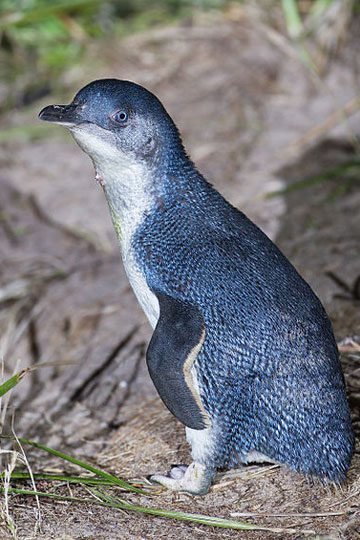 View Larger Map A marks the location of Papamoa Beach in the Bay of Plenty. An oil spill from a grounded container ship in New Zealand’s Bay of Plenty is threatening to worsen as authorities fear the ship is breaking up. Already, 350 tons of oil from the ship, the MV Rena, has leaked out […]
View Larger Map A marks the location of Papamoa Beach in the Bay of Plenty. An oil spill from a grounded container ship in New Zealand’s Bay of Plenty is threatening to worsen as authorities fear the ship is breaking up. Already, 350 tons of oil from the ship, the MV Rena, has leaked out […]
Sowing the seeds to save the Patagonian Sea
.568.jpg) The coastline of the ‘Patagonian Sea’ covered with seabirds and seals. Photo by: W. Conway. Claudio Campagna will be speaking at the Wildlife Conservation Network Expo in San Francisco on October 1st, 2011. With wild waters and shores, the Patagonia Sea is home to a great menagerie of marine animals: from penguins to elephants seals, […]
The coastline of the ‘Patagonian Sea’ covered with seabirds and seals. Photo by: W. Conway. Claudio Campagna will be speaking at the Wildlife Conservation Network Expo in San Francisco on October 1st, 2011. With wild waters and shores, the Patagonia Sea is home to a great menagerie of marine animals: from penguins to elephants seals, […]
New seabird discovered from Hawaii, but no one knows where it lives
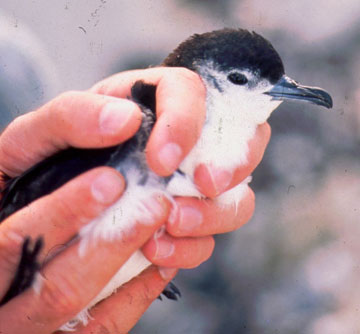 Researchers have uncovered a new seabird native to Hawaii stuffed in a museum. Originally identified as a smaller variation of a little shearwater (Puffinus assimilis), DNA tests showed that the bird, which was collected over four decades ago, was in fact a unique species. Named Bryan’s shearwater (Puffinus bryani), the fate of this bird in […]
Researchers have uncovered a new seabird native to Hawaii stuffed in a museum. Originally identified as a smaller variation of a little shearwater (Puffinus assimilis), DNA tests showed that the bird, which was collected over four decades ago, was in fact a unique species. Named Bryan’s shearwater (Puffinus bryani), the fate of this bird in […]
Shell spills over 50,000 gallons of oil off Scotland
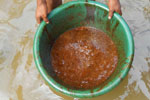 Yesterday, Royal Dutch Shell estimated that to date 54,600 gallons of oil had spilled into the North Sea off the east coast of Scotland, spreading some 19 miles wide (30 kilometers) at its maximum. While the company stopped the initial leak on Thursday, it has now announced that the oil has found a ‘second pathway’ […]
Yesterday, Royal Dutch Shell estimated that to date 54,600 gallons of oil had spilled into the North Sea off the east coast of Scotland, spreading some 19 miles wide (30 kilometers) at its maximum. While the company stopped the initial leak on Thursday, it has now announced that the oil has found a ‘second pathway’ […]
Feeds: news | india | latam | brasil | indonesia
 Although only a nuisance in your home, on an isolated island chain (archipelago) off the northeastern coast of Brazil, rats pose a threat to the red-billed tropicbird (Phaethon aethereus). The seabird nests in the remote Abrolhos National Park, but two species of invasive rats prey on its eggs and young: the house rat (Rattus […]
Although only a nuisance in your home, on an isolated island chain (archipelago) off the northeastern coast of Brazil, rats pose a threat to the red-billed tropicbird (Phaethon aethereus). The seabird nests in the remote Abrolhos National Park, but two species of invasive rats prey on its eggs and young: the house rat (Rattus […] Joanna Alfaro Shigueto will be speaking at the Wildlife Conservation Network Expo in San Francisco on October 11th, 2014. Marine conservationists often view fisheries as an enemy of sorts, vacuuming up fish with little thought to the long-term consequences and using equipment that also ends up killing other species, i.e. bycatch like sea turtles and […]
Joanna Alfaro Shigueto will be speaking at the Wildlife Conservation Network Expo in San Francisco on October 11th, 2014. Marine conservationists often view fisheries as an enemy of sorts, vacuuming up fish with little thought to the long-term consequences and using equipment that also ends up killing other species, i.e. bycatch like sea turtles and […] A migratory shorebird that has flown more than 400,000 miles has reappeared once again. The bird, dubbed “B95” after the number on his leg band or “Moonbird” for the distance he has flown over his lifespan, is a rufus red knot (Calidris canutus rufus) that scientists have been tracking for 19 years. Each May his […]
A migratory shorebird that has flown more than 400,000 miles has reappeared once again. The bird, dubbed “B95” after the number on his leg band or “Moonbird” for the distance he has flown over his lifespan, is a rufus red knot (Calidris canutus rufus) that scientists have been tracking for 19 years. Each May his […] The bleached bones of seabirds are telling us a new story about the far-reaching impacts of industrial fisheries on today’s oceans. Looking at the isotopes of 250 bones from Hawaiian petrels (Pterodroma sandwichensis), scientists have been able to reconstruct the birds’ diets over the last 3,000 years. They found an unmistakable shift from big prey […]
The bleached bones of seabirds are telling us a new story about the far-reaching impacts of industrial fisheries on today’s oceans. Looking at the isotopes of 250 bones from Hawaiian petrels (Pterodroma sandwichensis), scientists have been able to reconstruct the birds’ diets over the last 3,000 years. They found an unmistakable shift from big prey […] Lesser known than coral reefs, marine seagrass ecosystems are rich in biodiversity and are powerhouses when it comes to sequestering carbon dioxide. Yet, much remains unknown about the ecology of seagrass beds, including detailed information on how seagrass spread their seeds and colonize new area. Now a recent study in Marine Ecology Progress Series documents […]
Lesser known than coral reefs, marine seagrass ecosystems are rich in biodiversity and are powerhouses when it comes to sequestering carbon dioxide. Yet, much remains unknown about the ecology of seagrass beds, including detailed information on how seagrass spread their seeds and colonize new area. Now a recent study in Marine Ecology Progress Series documents […] It sounds ludicrous, but it could just be true: scientists say seagulls may be responsible for hundreds of southern right whale mortalities off the Argentine coastline. Since 2003, scientists have documented the deaths of 605 southern right whales (Eubalaena australis) near Península Valdés which the whales use as a nursery. Notably, 88 percent of these […]
It sounds ludicrous, but it could just be true: scientists say seagulls may be responsible for hundreds of southern right whale mortalities off the Argentine coastline. Since 2003, scientists have documented the deaths of 605 southern right whales (Eubalaena australis) near Península Valdés which the whales use as a nursery. Notably, 88 percent of these […] This post is an expanded version of an article that appeared in August on Yale e360: Easing The Collateral Damage Fisheries Inflict on Seabirds.
This post is an expanded version of an article that appeared in August on Yale e360: Easing The Collateral Damage Fisheries Inflict on Seabirds. Adelie penguins hunting for food. Photo by: J. Weller. Click to enlarge. Pablo Garcia Borboroglu will be speaking at the Wildlife Conservation Network Expo in San Francisco on October 13th, 2012. Penguins have spent years fooling us. With their image seemingly every where we turn—entertaining us in animated films, awing us in documentaries, and winking […]
Adelie penguins hunting for food. Photo by: J. Weller. Click to enlarge. Pablo Garcia Borboroglu will be speaking at the Wildlife Conservation Network Expo in San Francisco on October 13th, 2012. Penguins have spent years fooling us. With their image seemingly every where we turn—entertaining us in animated films, awing us in documentaries, and winking […]-ZSL.1.568.jpg) Keeper, Vicky Fryson, helps a Humboldt penguin chick, Pickle, test the water for the first time. Photo by: Zoological Society of London’s (ZSL) London Zoo. Humboldt penguins was found along the western edge of South America in Chile and Argentina. They face a barrage of threats including overfishing, drowning as bycatch, El Nino conditions that […]
Keeper, Vicky Fryson, helps a Humboldt penguin chick, Pickle, test the water for the first time. Photo by: Zoological Society of London’s (ZSL) London Zoo. Humboldt penguins was found along the western edge of South America in Chile and Argentina. They face a barrage of threats including overfishing, drowning as bycatch, El Nino conditions that […] Magellanic penguin in Patagonia. Photo by: Michaël Catanzariti. In recent weeks, 512 Magellanic penguins (Spheniscus magellanicus) have washed up dead in Brazilian state of Rio Grande do Sul. Although badly composed, researchers do not see any obvious signs why the penguins died, especially in such numbers. Marine biologists are currently performing autopsies on carcasses and […]
Magellanic penguin in Patagonia. Photo by: Michaël Catanzariti. In recent weeks, 512 Magellanic penguins (Spheniscus magellanicus) have washed up dead in Brazilian state of Rio Grande do Sul. Although badly composed, researchers do not see any obvious signs why the penguins died, especially in such numbers. Marine biologists are currently performing autopsies on carcasses and […] B95, the remarkable rufus red knot who has flown from the Earth to the moon in terms of distance. Photo by: Jan Van de Kam. He is so long-lived that he has surpassed all expectations, touching hearts throughout the American continent, bringing together scientists and schools, inspiring a play and now even his own biography. […]
B95, the remarkable rufus red knot who has flown from the Earth to the moon in terms of distance. Photo by: Jan Van de Kam. He is so long-lived that he has surpassed all expectations, touching hearts throughout the American continent, bringing together scientists and schools, inspiring a play and now even his own biography. […] Beach on Palmyra Atoll. Ecologists have long argued that everything in the nature is connected, but teasing out these intricate connections is not so easy. In fact, it took research on a remote, unoccupied island for scientists to discover that manta ray abundance was linked to seabirds and thereby native trees. Working in the U.S. […]
Beach on Palmyra Atoll. Ecologists have long argued that everything in the nature is connected, but teasing out these intricate connections is not so easy. In fact, it took research on a remote, unoccupied island for scientists to discover that manta ray abundance was linked to seabirds and thereby native trees. Working in the U.S. […] Two Kairuku penguins come ashore, passing a stranded Waipatia dolphin. Artwork by Chris Gaskin, owner and copyright owner: Geology Museum, University of Otago.. Around 25 million years ago a penguin with a long, sharp beak and massive flippers lived in a New Zealand that was almost entirely underwater. The bird, named Kairuku after a Maori […]
Two Kairuku penguins come ashore, passing a stranded Waipatia dolphin. Artwork by Chris Gaskin, owner and copyright owner: Geology Museum, University of Otago.. Around 25 million years ago a penguin with a long, sharp beak and massive flippers lived in a New Zealand that was almost entirely underwater. The bird, named Kairuku after a Maori […] It has long been known that overfishing has decimated some populations of tuna, shark, cod, as well as other big predatory fish; however two recent studies have pointed out that overfishing is also threatening small fish such as anchovies, sardines, mackerel, herring, menhaden, and krill. Although tiny, these species are vital to marine ecosystems since […]
It has long been known that overfishing has decimated some populations of tuna, shark, cod, as well as other big predatory fish; however two recent studies have pointed out that overfishing is also threatening small fish such as anchovies, sardines, mackerel, herring, menhaden, and krill. Although tiny, these species are vital to marine ecosystems since […] White capped albatross killed by oil. This species is listed as Near Threatened by the IUCN Red List. Photo ©: Forest & Bird. According to the New Zealand government an oil spill from a grounded container ship in the Bay of Plenty has killed 1,250 seabirds with hundreds of others in rescue centers. However, conservationists […]
White capped albatross killed by oil. This species is listed as Near Threatened by the IUCN Red List. Photo ©: Forest & Bird. According to the New Zealand government an oil spill from a grounded container ship in the Bay of Plenty has killed 1,250 seabirds with hundreds of others in rescue centers. However, conservationists […] View Larger Map A marks the location of Papamoa Beach in the Bay of Plenty. An oil spill from a grounded container ship in New Zealand’s Bay of Plenty is threatening to worsen as authorities fear the ship is breaking up. Already, 350 tons of oil from the ship, the MV Rena, has leaked out […]
View Larger Map A marks the location of Papamoa Beach in the Bay of Plenty. An oil spill from a grounded container ship in New Zealand’s Bay of Plenty is threatening to worsen as authorities fear the ship is breaking up. Already, 350 tons of oil from the ship, the MV Rena, has leaked out […].568.jpg) The coastline of the ‘Patagonian Sea’ covered with seabirds and seals. Photo by: W. Conway. Claudio Campagna will be speaking at the Wildlife Conservation Network Expo in San Francisco on October 1st, 2011. With wild waters and shores, the Patagonia Sea is home to a great menagerie of marine animals: from penguins to elephants seals, […]
The coastline of the ‘Patagonian Sea’ covered with seabirds and seals. Photo by: W. Conway. Claudio Campagna will be speaking at the Wildlife Conservation Network Expo in San Francisco on October 1st, 2011. With wild waters and shores, the Patagonia Sea is home to a great menagerie of marine animals: from penguins to elephants seals, […] Researchers have uncovered a new seabird native to Hawaii stuffed in a museum. Originally identified as a smaller variation of a little shearwater (Puffinus assimilis), DNA tests showed that the bird, which was collected over four decades ago, was in fact a unique species. Named Bryan’s shearwater (Puffinus bryani), the fate of this bird in […]
Researchers have uncovered a new seabird native to Hawaii stuffed in a museum. Originally identified as a smaller variation of a little shearwater (Puffinus assimilis), DNA tests showed that the bird, which was collected over four decades ago, was in fact a unique species. Named Bryan’s shearwater (Puffinus bryani), the fate of this bird in […] Yesterday, Royal Dutch Shell estimated that to date 54,600 gallons of oil had spilled into the North Sea off the east coast of Scotland, spreading some 19 miles wide (30 kilometers) at its maximum. While the company stopped the initial leak on Thursday, it has now announced that the oil has found a ‘second pathway’ […]
Yesterday, Royal Dutch Shell estimated that to date 54,600 gallons of oil had spilled into the North Sea off the east coast of Scotland, spreading some 19 miles wide (30 kilometers) at its maximum. While the company stopped the initial leak on Thursday, it has now announced that the oil has found a ‘second pathway’ […]